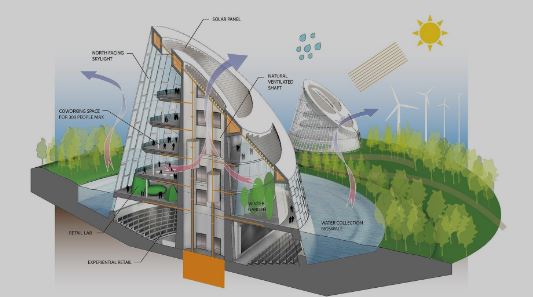The Power of Sustainable Structural Design for Infrastructure Projects
As the world grapples with the challenges of climate change, environmental degradation, and rapid As climate change, environmental degradation, and urbanization accelerate, sustainable structural design has become a necessity. The way we build our infrastructure directly impacts our planet’s health and future. We must prioritize sustainable practices in construction projects. Whether it’s green buildings or eco-conscious transportation systems, sustainability isn’t just a buzzword—it’s essential for future generations.
This blog explores the power of sustainable structural design. We’ll look at its benefits for the environment, economy, and community. We’ll also highlight the latest technologies and key considerations for creating greener, more resilient infrastructure.
1. The importance of sustainable infrastructure development
Climate change has made the need for sustainable infrastructure more urgent than ever. Traditional projects often emphasize speed and cost, which leads to environmental harm and inequality. Thankfully, mindsets are changing. More people now realize that infrastructure shapes our planet’s future. Sustainable design isn’t optional—it’s essential.
By integrating sustainable principles, we can lower emissions, improve community well-being, and enhance economic resilience. This shift calls for rethinking everything—from materials and technologies to how we engage with stakeholders. A holistic approach that balances environmental, social, and economic goals is key. When we design with sustainability in mind, we build a healthier, more prosperous world.
2. What is sustainable structural design?
Sustainable structural design transforms how we approach construction. Unlike traditional methods, it balances structural integrity with minimal environmental impact. This shift is driven by growing awareness of climate change, resource scarcity, and social equity.
The approach considers every project phase—from planning to decommissioning. It uses innovative materials and efficient construction techniques to conserve resources and reduce waste. Importantly, it also emphasizes stakeholder engagement and social responsibility, ensuring the final product benefits both people and the planet.
3. The role of structural design in building a better future
Global challenges—such as population growth and climate change—demand more responsible design. Sustainable structural design helps meet these needs while protecting the planet. With greener technologies and smarter materials, we can create resilient, low-impact structures.
This design philosophy considers a structure’s entire lifecycle. That includes planning, use, demolition, and recycling. It reduces waste, saves energy, and uses renewable resources. From highways to eco-buildings, sustainable design is vital for our collective future.
4. The environmental impact of traditional infrastructure projects
Traditional infrastructure often harms the environment. High-emission materials like steel and concrete contribute to pollution, deforestation, and habitat destruction. Extracting and processing these materials depletes natural resources and pollutes air and water.
The damage doesn’t stop once construction ends. Infrastructure like roads and buildings can increase urban sprawl, which raises energy use and destroys green space. Ongoing maintenance also adds to the environmental toll through heavy machinery and harmful chemicals.
5. Benefits of sustainable structural design in infrastructure projects
Adopting sustainable structural design in infrastructure projects is not only a moral obligation, but also a crucial step towards creating a better future for our planet. By incorporating environmentally friendly materials, minimizing waste, and optimizing energy efficiency, sustainable structural design can significantly reduce the ecological footprint of infrastructure projects. This approach not only benefits our planet, but also yields numerous economic and social benefits. For instance, sustainable buildings can reduce energy consumption by up to 50%, resulting in substantial cost savings for building owners and occupants. Additionally, sustainable infrastructure can also improve the health and well-being of the community, as natural light and ventilation can reduce the need for artificial lighting and heating, creating a healthier indoor environment. Furthermore, sustainable design can also increase the lifespan of infrastructure, reducing the need for costly repairs and replacements, and ultimately, creating a more resilient and adaptable infrastructure. By embracing sustainable structural design, we can create a better future for ourselves and for future generations, while also reaping the countless benefits that come with it.
6. How to identify and prioritize sustainable design opportunities
As you embark on the journey of designing a sustainable infrastructure project, identifying and prioritizing sustainable design opportunities is crucial to its success. This involves conducting a thorough analysis of the project’s environmental, social, and economic impacts to identify areas where sustainable design can make a significant difference. This is often referred to as a “sustainability assessment” or “life cycle assessment”.
A comprehensive sustainability assessment considers factors such as energy efficiency, water conservation, waste reduction, and the use of renewable materials. It also evaluates the potential environmental impacts of the project, including air and water pollution, noise pollution, and habitat disruption. By taking a holistic approach to sustainability, you can identify areas where sustainable design can be implemented to minimize the project’s environmental footprint and maximize its long-term benefits.
Prioritizing sustainable design opportunities involves ranking the identified opportunities based on their potential impact and feasibility. This involves considering factors such as cost, technical feasibility, and regulatory requirements. By prioritizing the most critical opportunities, you can ensure that your project is designed to meet its sustainability goals while also meeting the needs of its stakeholders.
7. Case study: A successful application of sustainable structural design
One exemplary example of the successful implementation of sustainable structural design is the redevelopment of the iconic Ponte 25 de Abril bridge in Lisbon, Portugal. The original bridge, built in 1966, was in dire need of a facelift to meet modern safety and environmental standards. The solution was a cutting-edge, sustainable design that not only preserved the bridge’s iconic status but also reduced its carbon footprint by 70%.
The new design incorporated advanced materials, such as high-strength, low-alloy steel, which allowed for a reduced weight and increased strength, resulting in significant energy savings. The bridge’s structural system was also reengineered to minimize the use of concrete, reducing the project’s environmental impact. Furthermore, the bridge’s new design incorporated a state-of-the-art drainage system, reducing the risk of flooding and improving water quality.
The results of this sustainable design are nothing short of impressive. The Ponte 25 de Abril bridge has been hailed as a model of sustainable infrastructure development, showcasing the potential for innovative design to drive environmental responsibility. The project’s success has also paved the way for similar initiatives in the region, demonstrating the power of sustainable structural design in shaping a better future for our communities and the planet.
8. The role of technology in sustainable structural design
As the world continues to evolve, so too must our approach to building and maintaining infrastructure. The integration of technology into sustainable structural design is a crucial step in creating a better future for our planet. The widespread adoption of innovative technologies, such as Building Information Modelling (BIM), has revolutionized the way architects, engineers, and contractors design and construct buildings. BIM enables the creation of highly detailed, data-rich models that can be shared across multiple stakeholders, reducing errors and increasing collaboration. This not only streamlines the construction process but also allows for more precise and efficient use of materials, resulting in a significant reduction of waste and environmental impact.
In addition to BIM, Artificial Intelligence (AI) is also playing a key role in sustainable structural design. AI-powered software can analyze complex data sets to identify optimal design solutions, taking into account factors such as natural light, ventilation, and energy efficiency. This AI-driven approach can help reduce the carbon footprint of buildings and infrastructure projects, making them more sustainable and environmentally friendly.
9. The importance of collaboration and stakeholder engagement
As the world grapples with the challenges of climate change, urbanization, and sustainability, the importance of collaboration and stakeholder engagement in infrastructure design has taken center stage. Gone are the days of isolated, siloed approaches, where architects, engineers, and contractors worked in isolation, without considering the needs and concerns of the broader community.
In the era of sustainable structural design, collaboration is key to unlocking the true potential of infrastructure projects. By bringing together diverse stakeholders, from local residents to government agencies, businesses, and environmental organizations, designers can create solutions that not only meet the needs of the project but also address the needs of the community.
Effective stakeholder engagement is crucial in understanding the unique concerns and aspirations of each group, and incorporating these into the design process. This may involve conducting public workshops, surveys, and focus groups, as well as establishing open communication channels to ensure that all voices are heard.
10. Overcoming barriers to sustainable structural design
As the world continues to grapple with the pressing issues of climate change, environmental degradation, and resource depletion, the construction industry is under increasing pressure to adopt sustainable practices. However, many infrastructure projects still face significant barriers to incorporating sustainable structural design principles. One of the primary hurdles is the lack of awareness and understanding of the benefits of sustainable design. Many architects, engineers, and contractors are not trained or equipped to design and build structures that are environmentally friendly, energy-efficient, and resilient.
Another major obstacle is the high upfront costs associated with sustainable design. While the long-term benefits of sustainable infrastructure are undeniable, the initial investment required to implement these designs can be prohibitively expensive. This can be especially challenging for small and medium-sized businesses, as well as developing countries, which may not have the resources to invest in sustainable infrastructure.
Conclusion and next steps
Sustainable design isn’t just about better buildings—it’s about a better world. With conscious practices and forward-thinking technology, we can reshape infrastructure to serve future generations.
Now is the time to act. Here’s how we move forward:
- Train professionals to prioritize sustainability
- Promote collaboration and knowledge sharing
- Embed sustainability in early planning stages
- Monitor environmental impacts and adapt designs accordingly
- Urge governments to invest in sustainable infrastructure
By following these steps, we turn vision into action—and build not just structures, but a sustainable legacy.
learn more: http://americanengineeringjournal.com/index.php/journal/article/view/2
Visit https://gdiengdesign.com/gdiengdesign-mep/

















































